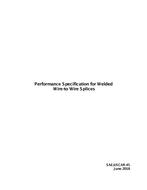Description
This SAE Standard is derived from SAE J2805 and specifies an engineering method for measuring the minimum noise emitted by road vehicles. The specifications reproduce the level of noise which is generated by the principal vehicle noise sources consistent with minimal noise emission in urban traffic. The method is designed to meet the requirements of simplicity as far as they are consistent with reproducibility of results under the operating conditions of the vehicle.The test method requires an acoustical environment which is only obtained in an extensive open space. Such conditions usually exist during: Measurements of vehicles for regulatory certification; Measurements at the manufacturing stage; Measurements at official testing stationsThe results obtained by this method give an objective measure of the noise emitted under the specified conditions of test. It is necessary to consider the fact that the subjective appraisal of the annoyance, perceptibility, and/or detectability of different motor vehicles or classes of motor vehicles due to their noise emission are not simply related to the indications of a sound measurement system. As annoyance, perceptibility, and/or detectability are strongly related to personal human perception, physiological human condition, culture, and environmental conditions, there are large variations and therefore these terms are not useful as parameters to describe a specific vehicle condition.Spot checks of vehicles chosen at random rarely occur in an ideal acoustical environment. If measurements are carried out on the road in an acoustical environment which does not fulfill the requirements stated in this SAE Standard, the results obtained may deviate appreciably from the results obtained using the specified conditions.In addition, this standard provides an engineering method to assess the performance of external sound generation systems intended for the purpose of providing acoustic information to pedestrians on a vehicle’s operating condition. This information is reported as objective criteria related to the external sound generation system’s sound pressure level, frequency content, and changes in sound pressure level and frequency content as a function of vehicle speed. As such, these measures can provide pedestrians with information on the location, speed, acceleration, and deceleration behavior of a vehicle.
Product Details
- Published:
- 09/22/2011
- File Size:
- 1 file , 250 KB




